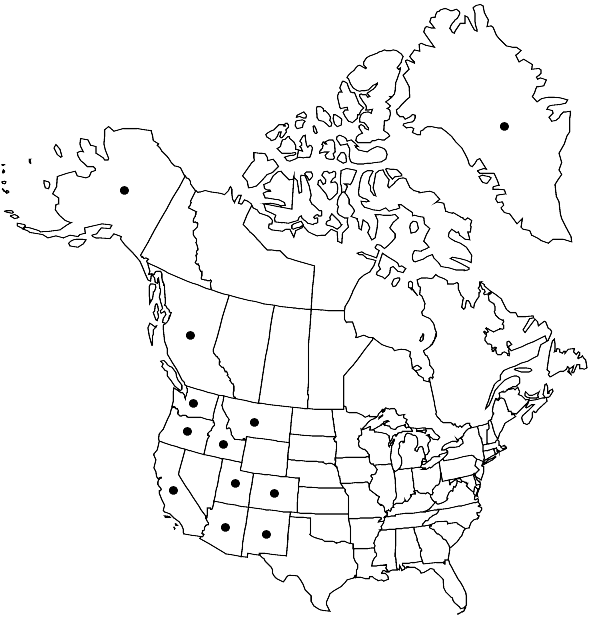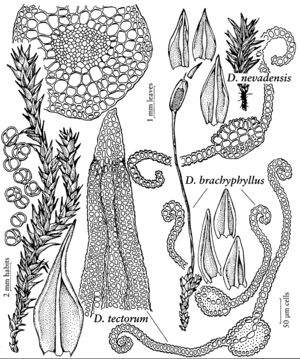Didymodon brachyphyllus
Phytologia 41: 24. 1978,.
Plants green to dark green, usually with a reddish cast. Stems to 1 cm, central strand present. Stem-leaves appressed to weakly spreading when dry, spreading but stiff and not keeled when moist, monomorphic, ovate to ovatelanceolate, grooved adaxially along the costa, often cucullate near leaf apex, 0.7–1 mm, base scarcely differentiated to ovate in shape, margins weakly recurved to near apex of leaf, entire, apex broadly acute or blunt, not fragile, often ending in 1–3 celled apiculus; costa ending shortly before the apex or percurrent, seldom weakly excurrent, often weakly spurred, little widened towards apex, little tapering, sometimes rather thick and bulging adaxially, lacking an adaxial thin-walled pad of cells or this poorly developed, adaxial costal cells quadrate to shortrectangular, 4 (–6) cells wide at mid leaf, guide cells in 1 (–2) layers; basal laminal cells differentiated medially or across the leaf, walls mostly thin, quadrate to shortrectangular, not perforated; distal laminal cells 7–10 µm wide, 1: 1, nearly smooth or papillae simple or 2-fid, 2–3 per lumen, lumens quadrate or roundedquadrate, walls somewhat thickened, weakly convex on both sides of lamina, distal leaf margins 1-stratose or occasionally 2-stratose in patches. Specialized asexual reproduction by axillary, multicellular gemmae. Seta 0.8–1 cm. Capsule 1.5–2.5 mm; peristome teeth rudimentary or 32, linear, twisted 1/2, 200–250 µm, delicate and commonly coming off with the operculum. Spores 10–13 µm. Distal laminal KOH reaction yellow or redbrown.
Phenology: Capsules mature spring–fall.
Habitat: Soil, limestone, lava, mortar, steppe, road banks, near spring, streamside, arid grassland, soil over lava, sandstone cliffs
Elevation: low to high elevations (80-2300 m)
Distribution

Greenland, B.C., Alaska, Ariz., Calif., Colo., Idaho, Mont., N.Mex., Oreg., Utah, Wash., Mexico, Atlantic Islands (Iceland), Antarctica
Discussion
A largely arid land species, Didymodon brachyphyllus, has an ovate leaf shape, margins only moderately recurved, and costa ending before the apex, which may terminate in a small conical cell or apiculus. Propagula are not always produced. Although the KOH reaction is commonly red, it may be yellow but not negative, as in D. tectorum. Didymodon luridus Sprengel (see R. H. Zander 1978e) does not occur in the flora area, though reported from there by many authors (often as D. trifarius, see Zander 1981). It differs in the triangular leaves and the smooth, more homogeneous and smaller distal laminal cells, 6–9 µm. American collections identified as this species are commonly actually D. brachyphyllus, D. nicholsonii, D. tophaceus, or D. vinealis. Small forms of D. nicholsonii have the leaf shape of D. brachyphyllus but the lamina is 2-stratose. Sterile Grimmia species are similar, but a small hyaline apex is commonly found on at least some Grimmia leaves. Small forms of D. vinealis may be confused with D. brachyphyllus but the latter never has lanceolate leaves, and its perichaetial leaves are also short and rather deltoid. Didymodon tectorum is similar but has larger leaves, usually green in nature, broadly rectangular leaf base, and an excurrent costa. Didymodon revolutus is similar but has unicellular gemmae. The exsiccat N. Amer. Musci Perf. 404, distributed by A. J. Grout as Husnotiella torquescens, is D. brachyphyllus with operculate sporophytes having rudimentary peristomes.
Selected References
None.
Lower Taxa
"um" is not declared as a valid unit of measurement for this property."um" is not declared as a valid unit of measurement for this property.
